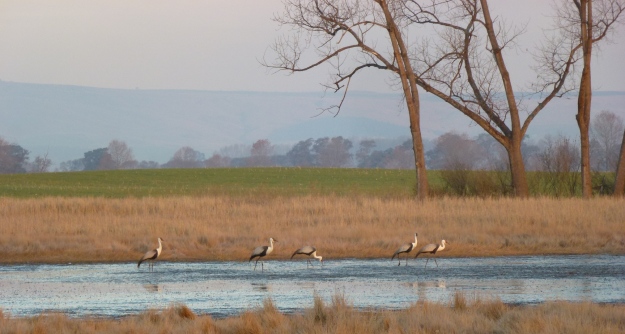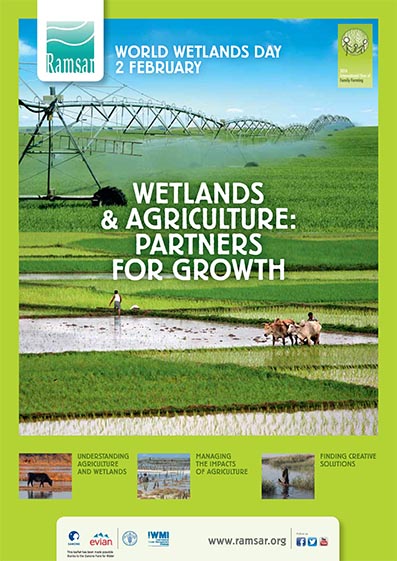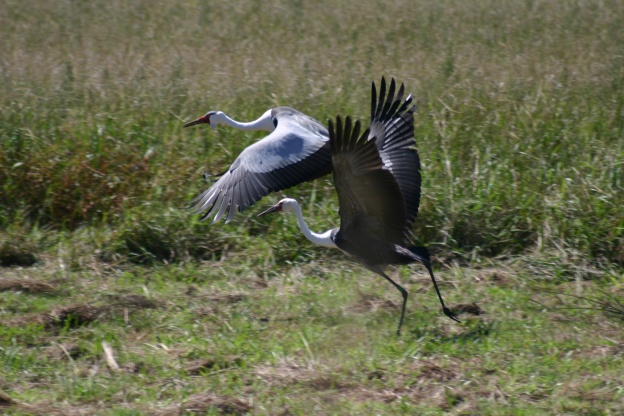Every year on the 2nd of February, the world celebrates World Wetland Day, a time to take stock of the value of wetlands to people and the health of our planet. World Wetland Day 2014 will also mark the culmination of one of the most successful Wattled Crane breeding seasons in recent times. The Endangered Wildlife Trust’s African Crane Conservation Programme (EWT-ACCP) and Ezemvelo KZN Wildlife (EKZNW) are excited to report that the 2013 KwaZulu-Natal aerial survey of cranes yielded the highest count of Wattled Crane’s since the start of the surveys 20 years ago!
261 Wattled Cranes, including chicks, were counted during the survey. While 55 breeding pairs monitored on the ground through the 2013 season have fledged a minimum of 21 chicks. Completely dependent on wetlands for their long-term survival and with approximately 85% of all South African Wattled Cranes being found on privately owned farms, this year’s World Wetlands Day theme ‘Wetlands and Agriculture’ is so appropriate.
“South Africa’s Wattled Crane population is finally stable and showing a slight increase in KwaZulu-Natal, where approximately 90% of the country’s population is found. We fitted leg colour rings to a total of 16 chicks this season – this is the highest number of Wattled Crane chicks ever ringed in one season since the start of colour ringing of Wattled Cranes in 1987. Colour ringing of chicks, under permit, allows us to answer critical questions including movement, survival, age of first breeding, sex ratio’s and proportions of adults that breed. This enables KZN Wildlife and us to monitor how well the population is doing and to implement conservation action appropriately,” said Tanya Smith, Senior Field Officer of the EWT-ACCP.
Each year, the province’s crane aerial survey totals approximately 25 hours of flying and covers roughly 20 000 km2 over five days. The results achieved would not be possible without the concerted effort by Ezemvelo KZN Wildlife and the EWT.
“A big thank you to the farmers who are actively involved in efforts to conserve Wattled Cranes and wetlands. Your involvement, commitment and passion has continued to grow each year. Collaboration eases many of the challenges we face in the field and helps us to achieve the kind of conservation results that benefit the species we are trying to preserve,” concluded Tanya.
Wattled Crane conservation in KwaZulu-Natal is sponsored by Rand Merchant Bank through the implementation of the EWT’s Drakensberg Crane and Wetland Conservation Project, in collaboration with Ezemvelo KZN Wildlife and KZN Crane Foundation. For more information on the annual crane aerial survey or any of the above initiatives, please contact Tanya Smith on tanyas@ewt.org.za
Contact:
Tanya Smith
Senior Field Officer
African Crane Conservation Programme
Endangered Wildlife Trust
Tel: +27 83 394 7476
tanyas@ewt.org.za
Brent Coverdale
Animal Scientist: Mammals and Birds
Ezemvelo KZN Wildlife
Tel: +27 33 845 1449
Brent.Coverdale@kznwildlife.com
Nomonde Mxhalisa
Communications Manager
The Endangered Wildlife Trust
Tel: +27 11 372 3600
nomondem@ewt.org.za


